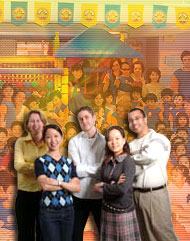Research over the last 10 to 15 years on how the brain works has led to new insights on learning and teaching strategies. Research on neuroplasticity has for example shown the brain to be far more flexible than was previously thought and along with other studies has demonstrated the enhanced positive effects and stimulus of active learning (one of the primary principles, upon which Happy Marian was founded).
The human brain is a remarkable organ consisting of approximately 100 billion neurons with approximately 1 quadrillion synapses (That’s 1,000,000,000,000,000 synapses) and we are only now starting to uncover some of its secrets. The degree of complexity of the human brain has prompted a number of eminent people in the scientific community such as Dr. Michio kaku, Professor Sir Robin Murray and Christ of Koch to call the human brain - “The most complicated object in the universe.” So if you add up all the students in your class and then multiply that number by 1 quadrillion you get an idea of the complexities and challenges of teaching. The good news is that science is putting its best foot forward in uncovering the secrets of the human brain.
Science has begun to study this structure in greater and greater detail. In fact, according to Dr. Michio Kaku we have learnt more about the human brain and how it works in the last 10 to 15 years than in all the preceding years put together.
Research over the last 10 to 15 years on how the brain works has led to new insights on learning and teaching strategies. Research on neuroplasticity has for example shown the brain to be far more flexible than was previously thought and along with other studies has demonstrated the enhanced positive effects and stimulus of active learning (one of the primary principles, upon which Happy Marian was founded). Further research in neuroplasticity and psychology has found that taking short breaks from an activity can improve problem solving and memory retention. In one experiment, students were given problem solving tasks that required them to “think outside the box” and the students who were given a break in the form of a simple activity for a short time and then asked to try again did far better than the students who were asked to simply keep trying.
Research into memory and problem solving has also shown that getting a good night’s sleep can also help improve memory retention, problem solving and even improve sporting performance. (Research suggests that dreaming plays a vital role in creating simulations and managing information).
Further research on memory seems to suggest that we can only remember 3 to 4 things in our working memory, rather than the previously held theory of seven. That is bad news for our students, but there is a light at the end of this tunnel, because the same research also shows that through grouping and clumping we can increase that number greatly. The trick is to use tagging, clumping, comprehension and grouping to improve our working memory. For example 1-7-8-5-9 -0 is 6 things to remember, but 178 and 590 is only 2. This also demonstrates why teaching new information with groups such as themes, spelling rules, sentence patterns, etc can be so effective.
Using our “most complicated structure in the universe” we will work to make your child's “most complicated structure in the universe” be the best it can be.
